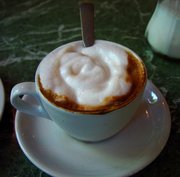Cappuccino
|
|
Cappuccino is an Italian beverage, prepared with espresso and milk. A cappuccino is generally defined as 1/3 espresso, 1/3 steamed milk and 1/3 frothed milk. Another definition would call for 1/3 espresso and 2/3 microfoam. A cappuccino differs from a latte, which is mostly milk and little foam. (A "dry cappuccino" has less milk.)
In Italy it is consumed almost exclusively early in the day for breakfast; in some other countries it may be consumed throughout the day or after dinner.
Besides a quality shot of espresso, the most important element in preparing a cappuccino is the texture and temperature of the milk. When a well-trained barista steams the milk for a cappuccino, he or she should create "microfoam" by introducing very tiny bubbles of air into the milk. This gives the milk an extremely velvety texture and sweet taste.
A cappuccino is ideally prepared in a ceramic coffee cup, which has far better heat retention characteristics than glass or paper.
In some places, skilled baristas create latte art when pouring properly steamed milk into the espresso, making designs such as hearts, leaves and rosettes.
Cappuccino was a taste largely confined to Europe and a few of the more cosmopolitan cities of North America until the mid-1990s when cappuccino was made much more widely available to North Americans, as part of the new upscale coffee bar chains with a consciously "European" air (notably Starbucks). By the first years of the 21st century cappuccino was being served by McDonald's.
The widespread acceptance in the U.S. of what was once regarded as a taste of affectatious Europhiles and older Italian-Americans has led to many establishments, such as convenience stores offering what they represent as cappuccino to their patrons. However, that product is usually an ersatz cappuccino, produced by machines similar to those that mix cocoa drinks where all the buyer need do is touch a button and position the cup properly. The drink that comes out is usually produced either from a preproduced mix or double-brewed coffee and bears little relation to the real thing.
Similar products result from home use of store-bought mixes usually advertised, more accurately, as producing "frothed coffee."
Origins
The origin of the name is made clear by the fact that in France at the beginning of the 18th century a new fashion arose in Paris (though not at Versailles) for carved wall-panelling boiseries that were left in their natural color (almost invariably oak) rather than being painted and gilded as in the previous century. The new mode, which coincided with the height of the controversy over Jansenisme that was dividing the tout Paris in stylish religious pamphleteering, was wittily termed à la capucine in reference to the brown color of the robes worn by the Capuchin order of Franciscan friars. This color-coded etymology is followed by the Oxford English Dictionary and the American Heritage Dictionary. The order of Capuchins was, in turn, named for the capucize (cappuccio), or long pointed cowl, worn by the friars. Similarly, the cream on a well-made cappuccino covers the beverage as a sort of cappuccio.
Traditionalist Catholics find the etymology mildly disrespectful, and offer a twist on a familiar coffee legend: after the Siege of Vienna (1683) was lifted, the Capuchin friar Marco d'Aviano (beatified in April 2003) invented the drink after the Ottoman Turks retreated, leaving bags of coffee beans in their tents. Allegedly, d'Aviano added milk and honey to sweeten the bitter coffee left by fleeing Turkish armies, though for a Viennese of the 17th or 21st century, coffee sweetened with honey would be an emblem of desperation. This same legend is more widely told of a Pole, Kolschitzky, in the aftermath of the Siege (see the entry Coffeehouse).
See also: Coffee, caffé, espresso
External link
- Foaming techniques, FAQ's on cappucino and espresso (http://www.toomuchcoffee.com/)

